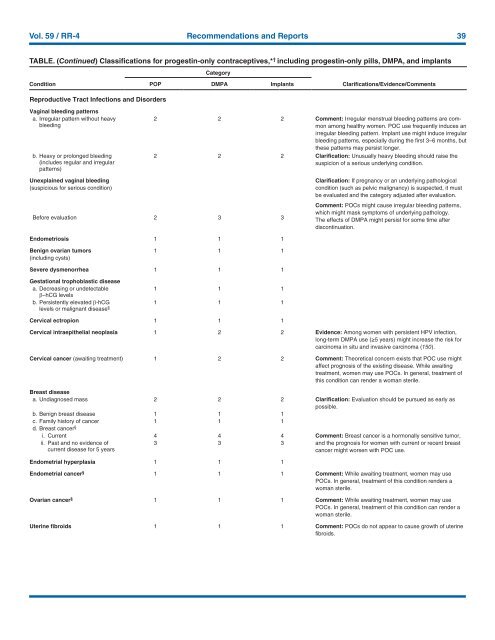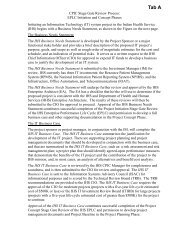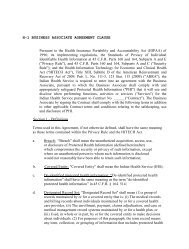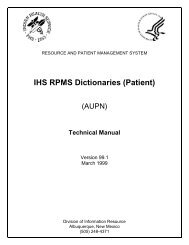CDC Article-US Medical Eligibility Criteria for Contraceptive Use, 2010
CDC Article-US Medical Eligibility Criteria for Contraceptive Use, 2010
CDC Article-US Medical Eligibility Criteria for Contraceptive Use, 2010
Create successful ePaper yourself
Turn your PDF publications into a flip-book with our unique Google optimized e-Paper software.
Vol. 59 / RR-4 Recommendations and Reports 39<br />
TABLE. (Continued) Classifications <strong>for</strong> progestin-only contraceptives,* † including progestin-only pills, DMPA, and implants<br />
Category<br />
Condition<br />
POP DMPA Implants<br />
Clarifications/Evidence/Comments<br />
Reproductive Tract Infections and Disorders<br />
Vaginal bleeding patterns<br />
a. Irregular pattern without heavy<br />
bleeding<br />
b. Heavy or prolonged bleeding<br />
(includes regular and irregular<br />
patterns)<br />
2 2 2 Comment: Irregular menstrual bleeding patterns are common<br />
among healthy women. POC use frequently induces an<br />
irregular bleeding pattern. Implant use might induce irregular<br />
bleeding patterns, especially during the first 3–6 months, but<br />
these patterns may persist longer.<br />
2 2 2 Clarification: Unusually heavy bleeding should raise the<br />
suspicion of a serious underlying condition.<br />
Unexplained vaginal bleeding<br />
(suspicious <strong>for</strong> serious condition)<br />
Be<strong>for</strong>e evaluation 2 3 3<br />
Clarification: If pregnancy or an underlying pathological<br />
condition (such as pelvic malignancy) is suspected, it must<br />
be evaluated and the category adjusted after evaluation.<br />
Comment: POCs might cause irregular bleeding patterns,<br />
which might mask symptoms of underlying pathology.<br />
The effects of DMPA might persist <strong>for</strong> some time after<br />
discontinuation.<br />
Endometriosis 1 1 1<br />
Benign ovarian tumors<br />
(including cysts)<br />
1 1 1<br />
Severe dysmenorrhea 1 1 1<br />
Gestational trophoblastic disease<br />
a. Decreasing or undetectable<br />
1 1 1<br />
β–hCG levels<br />
b. Persistently elevated β-hCG<br />
levels or malignant disease § 1 1 1<br />
Cervical ectropion 1 1 1<br />
Cervical intraepithelial neoplasia 1 2 2 Evidence: Among women with persistent HPV infection,<br />
long-term DMPA use (≥5 years) might increase the risk <strong>for</strong><br />
carcinoma in situ and invasive carcinoma (150).<br />
Cervical cancer (awaiting treatment) 1 2 2 Comment: Theoretical concern exists that POC use might<br />
affect prognosis of the existing disease. While awaiting<br />
treatment, women may use POCs. In general, treatment of<br />
this condition can render a woman sterile.<br />
Breast disease<br />
a. Undiagnosed mass 2 2 2 Clarification: Evaluation should be pursued as early as<br />
possible.<br />
b. Benign breast disease 1 1 1<br />
c. Family history of cancer 1 1 1<br />
d. Breast cancer §<br />
i. Current 4 4 4 Comment: Breast cancer is a hormonally sensitive tumor,<br />
ii. Past and no evidence of<br />
current disease <strong>for</strong> 5 years<br />
3 3 3<br />
Endometrial hyperplasia 1 1 1<br />
and the prognosis <strong>for</strong> women with current or recent breast<br />
cancer might worsen with POC use.<br />
Endometrial cancer § 1 1 1 Comment: While awaiting treatment, women may use<br />
POCs. In general, treatment of this condition renders a<br />
woman sterile.<br />
Ovarian cancer § 1 1 1 Comment: While awaiting treatment, women may use<br />
POCs. In general, treatment of this condition can render a<br />
woman sterile.<br />
Uterine fibroids 1 1 1 Comment: POCs do not appear to cause growth of uterine<br />
fibroids.
















